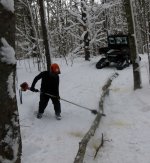Stihl did have some good points in there info, part of which is pasted below. We do switch out the warm/cool carburetor air vent. There point of snow, wood chips, debris and oil clogging the chain cover is the largest problem we encounter while cutting trails in the snow. The snow does make this frequently happen but I'm not sure this is what the original poster cared to hear about. But no, we're not going to change the chains cutting teeth by 5 degrees, because its now below freezing today.... I'll add a couple of "working in the woods" photos...
(from the Stihl link)
Winter Chainsaw Maintenance and Operation
The first thing to do to prepare your chainsaw for use in temperatures under 40ー F is to switch the winter/summer shutter on your saw to 努inter to activate the carburetor pre-heater system, if your chainsaw has this feature. Leaving the shutter on the summer position could result in carburetor icing, causing the machine to perform poorly, idle erratically, and even run lean, which could eventually cause major engine failure.
Your chainsaw will require some extra maintenance during winter. The following are some basic recommendations:
Be sure to keep the sprocket cover clean to prevent snow and moisture from freezing with sawdust and oil that normally collect around the sprocket area.
Clean the chain brake more often, especially with chainsaws that have the chain brake in the sprocket cover.
Remove snow from around the fuel tank opening before refueling, so snow doesn't fall in the tank; water and moisture in the fuel can cause unnecessary aggravation.
Keep the anti-vibration system free from snow and ice that could freeze and affect operation of the anti-vibration system, resulting in increased operator fatigue.
Wipe away any snow, ice or water droplets from around the throttle trigger and throttle trigger interlock to ensure they remain operational.
Also keep the cooling air intake clean and free from snow, ice and sawdust to prevent your engine from overheating. Take care that bulkier winter clothing does not get sucked up against the cooling air intake. This can restrict air flow and cause major engine failure.
Be extra attentive to risk-reducing features and control mechanisms on your chainsaw and keep them clean.
Special Weather-Related Precautions
Be aware that the ground might be frozen and slippery. You will need solid footing with good traction. With all your winter tree work, take extreme care in the freezing weather. When it's windy, stormy or rainfall is heavy, consider delaying the work to avoid hazards.
Since frozen wood is harder than non-frozen wood, you may want to decrease the saw chain痴 filing angle by five degrees. Decreasing the chain痴 angle increases cutting performance in frozen woods and decreases the wear to your guide bar and saw chain.
Keep ice from building up on the handles of your chainsaw to prevent your hands from slipping off the machine. Before you start felling, try to remove the snow around the trunk of the tree and knock off as much snow and ice as possible from low hanging limbs, which pose an increased risk of distraction from falling snow while you are cutting the tree.
As you face the challenges of winter work, taking a few extra maintenance steps and being extra alert to potential hazards can increase the productivity of your equipment and reduce the risk of injury.
Randy Scully is product service manager for STIHL Inc., based in Virginia Beach, Virginia.


